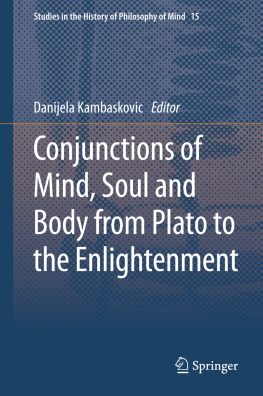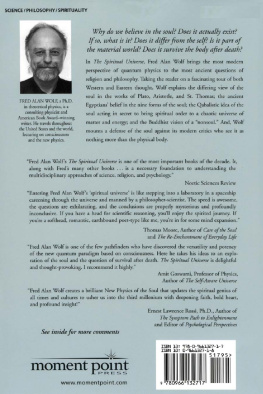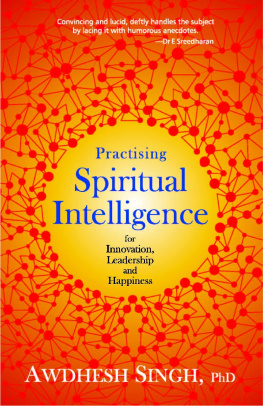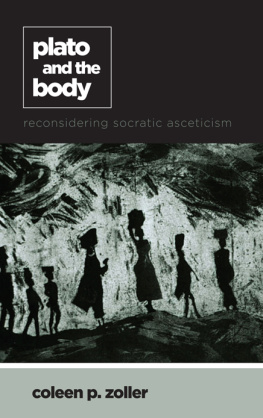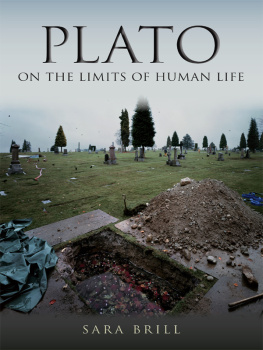Henry Peachams 1577 handbook on rhetoric, The Garden of Eloquence, suggests that it is profitable to enliven our writing by drawing on the tendency of our thoughts to wander naturally between material and immaterial things, allowing us to use words that do belong properly to the mind to denote properties of the bodie. Using this technique, a wound can be memorably described as angrie or wofull, an eye is pitifull and an ear wise (Peacham , p. 251) and the discipline of the history of mind, as well as in the questions of belief and experience, both individual and cultural.
The purpose of this book is to examine the nexus between the corporeal, emotional, spiritual and intellectual aspects of human life as represented in the writing of the Middle Ages and the Renaissance over two thousand years of Western thought, from Plato in the fifth century BC and the fourth century AD Byzantine dialogues on the soul, to the philosophical and medical writings of the early 1700s. I wanted to examine the question from as many perspectives as possible, which is why I contacted people working in very different fields and periods. In this book, scholars whose disciplines are rarely brought into conversation, agreed to consider the subject of the conjunctions of the body, mind and spirit.
In the mainstream Aristotelian tradition, the mind was seen to inhabit the body thecorporeal, sensory part that humans share with animals and the higher sphere; the intellectual part or the soul (Kemp and Fletcher, ), p. 565.) There is no clear way to relate these theories to the modern-day distinctions between subconscious, unconscious or conscious mental activity; it is nevertheless clear that these theories foreshadow later discussions on the role of the different levels of mind in conscious decision making.
In the ancient Hebrew tradition, the soul was divided into three parts: Nefesh , the lower or animal part, linked to instincts and bodily cravings; Ruach , the middle soul or the spirit, which contains moral virtues and the ability to distinguish between good and evil; and Neshamah , the higher or super-soul, which separates man from other life forms. This part is linked with the intellect and allows the awareness of the existence and presence of God. According to the Kabbalah and the Hebrew mystical tradition, every human is born with least one element in their soul; with the proper study a person can eventually develop two higher levels of the soul. The tripartite division is reminiscent of the Freudian division into id, ego and superego (Ableson , pp. 157158).
Plato believed in different types of the soul (Phaedrus 271d) all with a fragile connection with the body (Laws 8.828d) in which it is imprisoned (Phaedo 81 sq, Phaedrus 250c). The view that the soul and body separate after death (Crat. 403b) was another view open to consideration in the Judaeo-Christian tradition. In the fifth century, St Augustine describes the soul as an immaterial substance made in the image of God, consisting, nevertheless, of memory, intellect, and will. In Renaissance Italy, Lorenzo Valla upholds the view that the soul is an incorporeal substance, allocating the question a separate chapter of his Repastinatio dialectice et philosophie (1439). Valla rejects the idea that we have different types of soul (vegetative, sensitive, imaginative, intellectual) on the grounds that this would indicate a plurality of souls (Valla , pp. 5973, 408410, and 418419), and on the grounds that locating the soul in various areas of the body would make it material, not immaterial, both of which ideas he considers contradictory to Christian doctrine.
The first section, Conjunction 1: Text and Self-Perception, focuses on the creativity and reception as loci of the conjunctions. Graeme Miles Body vs. Soul, Text vs. Interpretation in Michael Psellos, Chap. (The Thin End of the Wedge: Self, Body and Soul in Rembrandts Kenwood Self-Portrait), introducing the notion of the enduring (spiritual) and the instrumental (bodily) self that the artist seeks to immortalise in auto-portraits.
The second section of the collection finds the nexus between body and soul in emotions. In Chap. , Grief and Desire, Body and Soul in Gregory of Nyssa Life of Saint Macrina, Michael Champion identifies grief and desire as conjunctions of body and soul. This may at first seem counter-intuitive, as the early medieval wont was to honour Apatheia, the absence of passions, which makes humans like angels; apatheia is preferred in Stoic as well as Christian contexts, and is sometimes proposed as a characteristic of God; but in his writing, Gregory of Nyssa conspicuously values desire, passions, grief and attachment, and justifies them eschatologically. By arguing that it is the passion of insatiability which makes it possible to enjoy the Divine, and that, without it, there would be no interaction with God, Gregory creates an original theology which rehabilitates an emotion that others consider a weakness what others consider a weakness. No less importantly, Gregory also introduces the discussion about the difference of the ineffable, inexpressible qualities and words which are used to describe them.
Robert S. Whites Variable Passions: Shakespeares Mixed Emotions, Chap. , which leads to tragedy. Bob Whites concept of character destiny is crucially important here: on one hand virtue is preserved by refusing to mingle and staying through to your path; on the other, it is Shakespeares morally single-minded characters who are ethically suspect.
Daniel Derrins Subtle Persuasions: The Memory of Bodily Experience as a Rhetorical Device in Francis Bacons Parliamentary Speeches, Chap. , Lessons in Music, Lessons in Love, Katherine Wallace discusses music as a place where body and soul come together. This resulted in a dual view of music in the medieval and Renaissance periods: one, as a source of nourishment for the soul, an asset to a young womans education and a symbol of virtue; and two, the source of the souls corruption. As young female musicians acquire physical skill, this skill becomes equated with their skill in pleasing a lover; the increased pleasure they take in their music becomes elided with sexual pleasure, and the very symbol of their moral degeneration.
Conjunction 3: Sex is the third section of our book, examining Renaissance views on sexuality and the sexual act. William Schippers Chap. , Quaint Knowledge: a Body-Mind Pattern across Shakespeares Career, Laurence Johnson links epistemology with sexuality by mapping the fortunes of the intriguing and multivalent word quaint (with cunt as one of its meanings) in early modern discourse.
The fourth and final section, Conjunction 4: Material Souls, engages with the way our bodies can leaves traces of our minds behind. Manfred Horstmanshoffs Chap. , The Material Soul: Strategies for Naturalising the Soul in Early Modern Epicurean Context explores, under an Epicurean heading, the concept of material soul as indicative of a non-dualistic tradition of thinking about soul and matter. While we are more familiar with the dualistic approach to the soul which many term Cartesian, arguing that the division between body and soul originated with Descartes, the Epicurean concept, deriving from Epicurus and Lucretius and reprised in expanded and ever-evolving forms by Gassendi, the anonymous manuscript Lme matrielle , Guillaume Lamy, La Mettrie and Diderot, shows that materialists did not have to reject the existence of the soul, but could instead materialise it.

